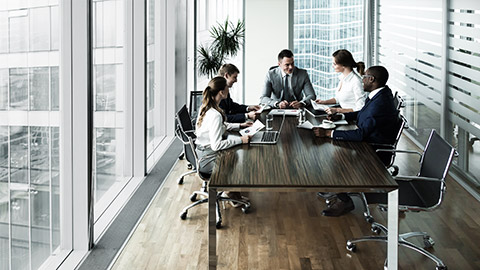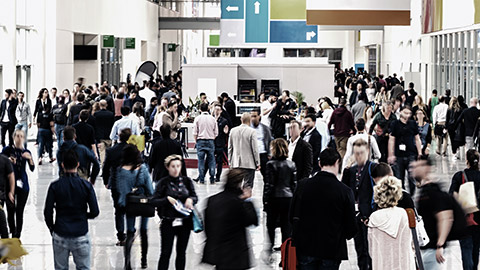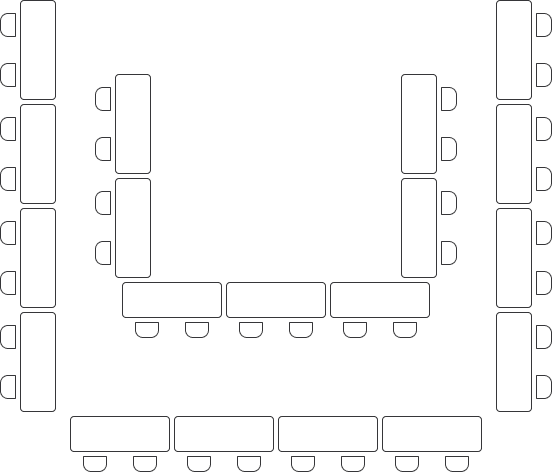In this topic, we’ll take a look at:
- Common types of work events.
- How to bring people together for events.
- Resources needed for events.
By the end of this topic, you’ll be able to:
- Identify the key characteristics of common types of work events.
- Describe the advantages and challenges of different event formats.
- Explain the differences between formal and informal event invitations and when each should be used.
- Describe key considerations for arranging travel for events.
- Describe the key considerations for organizing venues, catering, and other resources for events.
As an administrator, you will most likely be involved in coordinating different types of events for your organisation. Make sure you refer to and follow relevant policies and procedures of your organisation.
Internal Meetings

Internal meetings are a vital part of organisational life, serving various purposes that contribute to the overall success and cohesion of the business.
Strategic Planning Sessions
Strategic planning sessions are focused on setting the long-term direction of the organisation. They involve key decision-makers, such as senior management and board members, who collaborate to define the company’s vision, mission, and goals.
During these sessions, participants analyse the current state of the organisation, evaluate internal and external factors (such as market trends and competition), and develop strategies to achieve desired outcomes. These sessions may also include setting key performance indicators (KPIs) and resource allocation.
The result is a strategic plan that guides the organisation’s activities and decision-making over a defined period, typically three to five years.
As an administrator, your tasks for strategic planning sessions could include:
- Coordinating logistics, including booking a venue or conference room, setting up audiovisual (AV) equipment, and preparing materials like agendas and handouts.
- Providing assistance during the session, such as note-taking, managing time, and handling technical issues.
- Distributing meeting minutes, action items, and any strategic documents post-session.
Department Workshops
Department workshops are focused, interactive meetings designed to address specific issues or projects within a particular department. These workshops are often used for problem-solving, training, brainstorming, or developing new initiatives.
Participants engage in activities such as group discussions, role-playing, case studies, and collaborative planning. The goal is to utilise the collective knowledge and skills of the team to generate solutions or ideas that benefit the department.
The outcomes of department workshops can include action plans, process improvements, new projects, or enhanced skills and knowledge among team members.
As an administrator, your tasks for department workshops could include:
- Organising the location, arranging seating, and ensuring all necessary materials (e.g., whiteboards, flip charts) are available.
- Assisting with workshop flow, including managing breaks, distributing materials, and supporting facilitators.
- Collecting and distributing workshop outputs, such as notes, brainstorming outcomes, and feedback.
Social Events

Social events are informal gatherings that help build relationships, foster teamwork, and improve morale within the organisation. They provide an opportunity for employees to connect with one another in a relaxed setting, away from the pressures of work.
Social events can include a wide range of activities such as team-building exercises, holiday parties, or after-work gatherings. These events often encourage interaction across departments and levels of hierarchy.
The primary outcomes of social events are stronger interpersonal relationships, a sense of community within the organisation, and enhanced employee engagement and satisfaction.
As an administrator, your tasks for social events could include:
- Handling venue selection, catering arrangements, invitations, and RSVPs.
- Overseeing event setup, ensuring the event runs smoothly, and managing any last-minute issues.
- Post-event: Gathering feedback, handling any post-event tasks, and updating event records.
Stakeholder Events
Stakeholder events play a significant role in building relationships, making important decisions, and ensuring the organisation's success. Here’s an overview of common types of stakeholder events:
- Contract Negotiations: Discussions between two or more parties aimed at reaching a mutually beneficial agreement. These negotiations can involve clients, suppliers, or partners and typically cover terms and conditions related to services, products, pricing, timelines, and responsibilities.
- Job Interviews: A key part of the recruitment process, allowing organisations to assess the suitability of candidates for specific roles. Interviews provide an opportunity to evaluate a candidate's skills, experience, and cultural fit within the organisation.
- Supplier Meetings: Focus on maintaining and strengthening relationships with suppliers. Discussions often cover contract terms, delivery schedules, quality control, and cost management.
- Customer Feedback Sessions: Used to gather insights from customers about their experiences with the organisation’s products or services. This can be in the form of focus groups, user testing, or customer advisory panels.
- Board Meetings: Regular gatherings of the company’s board of directors to discuss and make decisions on strategic issues, corporate governance, and overall direction of the organisation.
As an administrator, your tasks for stakeholder events could include:
- Arranging meetings by coordinating times that work for all parties, booking appropriate rooms, and sending out invitations.
- Ensuring all sensitive materials and discussions are handled with discretion, including managing documentation securely.
- Providing administrative support during the event, such as note-taking and organising documents.
External-Facing Events
Product Launches
A product launch serves as the formal introduction of a new product or service to the target market. It aims to create awareness, build anticipation, and generate interest among potential customers.
Launches help position the product within the marketplace, highlighting its unique selling points and differentiating it from competitors.
Administrators may be involved in some or all the key stages of a product launch, which includes:
- Pre-launch Preparation: This phase includes market research, product development, and the creation of a marketing strategy. Businesses often engage in teaser campaigns, social media promotions, and PR activities to build hype before the official launch.
- Launch Event: The main event could be a press conference, a live demonstration, an online webinar, or a special event for key stakeholders, influencers, and media. This is where the product is unveiled, often accompanied by presentations, product demos, and customer testimonials.
- Post-launch Follow-up: After the product is introduced, businesses focus on sustaining the momentum through marketing campaigns, customer engagement, and continuous monitoring of sales and customer feedback. This stage might include special promotions, customer support initiatives, and further media outreach.
As an administrator, your tasks for product launches could include:
- Working with marketing and product teams to arrange the venue, invite attendees, and manage event logistics.
- Assisting in distributing promotional materials, coordinating with media, and ensuring product samples are available.
- Providing on-site support during the launch, managing registration, and ensuring the event runs smoothly.
Trade Shows

Trade shows are large-scale events where businesses within a specific industry showcase and demonstrate their products or services to potential customers, partners, and industry professionals. These events are pivotal for networking, generating leads, and gaining market insights.
Key activities of trade shows can include:
- Exhibition Booths: Companies set up booths or displays to showcase their offerings. These booths often include product demonstrations, samples, and marketing materials designed to attract visitors and encourage engagement.
- Presentations and Workshops: Many trade shows feature presentations, panel discussions, and workshops where industry experts share insights, innovations, and best practices. These sessions provide educational value and position companies as thought leaders.
- Networking Events: Social events, luncheons, and after-parties are common at trade shows, offering informal opportunities for networking and relationship-building.
- Product Launches: Some companies choose to unveil new products at trade shows to capitalise on the large audience and media presence, ensuring maximum exposure.
As an administrator, your tasks for trade shows could include:
- Coordinating logistics for setting up the company’s booth, including shipping materials, arranging travel for staff, and organising promotional items.
- Ensuring the booth is properly staffed, managing schedules, and handling logistical issues that arise during the show.
- Collecting and organising leads or contacts made during the event, distributing follow-up communications, and managing post-event reporting.
Event formats
-
Events can be held either in-person, online, or in a hybrid format. Each format offers advantages and challenges, depending on the goals, audience, and resources of the event.
In-Person Events
| Advantages | Challenges |
|---|---|
|
|
Online Events
| Advantages | Challenges |
|---|---|
|
|
Hybrid Events
| Advantages | Challenges |
|---|---|
|
|
Event Invitations
Event invitations serve as formal or informal communication tools to inform and engage stakeholders, setting the tone and expectations for the event. Whether digital or printed, they convey essential details and reflect the nature and importance of the occasion.
Formal events like formal ceremonies, milestone celebrations, or corporate dinners may call for printed or well-designed digital invitations. Informal events, casual gatherings, or internal meetings can be effectively managed with email or calendar invites.
Consider the preferences of the invitees. Traditional audiences might appreciate a printed invitation, while a tech-savvy group might prefer the convenience of digital or calendar invites.
If budget and time are constraints, digital invitations or calendar invites offer a quick and cost-effective solution.
Characteristics
| Formal Invitations | Informal Invitations |
|---|---|
| Design: Typically feature sophisticated, elegant designs with high-quality materials if printed (such as thick cardstock, embossing, or foil stamping). Digital versions might include interactive elements but still maintain a formal aesthetic. | Design: Usually simple and straightforward, with less emphasis on formal design elements. They may use casual fonts, bright colours, and minimalistic layouts. |
| Language: The wording is often more elaborate and ceremonious, including traditional phrases such as “You are cordially invited” or “The honour of your presence is requested.” | Language: The language is more relaxed and conversational, with phrases like “Join us for” or “You’re invited to.” |
| Delivery: Can be delivered physically (via mail) or digitally (via email or specialised online platforms). Physical invitations often add a tangible, memorable touch. | Delivery: Typically delivered via email, messaging apps, or calendar invites. They focus on convenience and quick distribution. |
| Essential details: Event title, date, time, venue (with a full address), dress code, RSVP details, and host or organisation name. | Essential details: Event title, date, time, venue, and RSVP details. |
| Additional information: Formal invitations may include directions, parking information, an agenda or itinerary, special instructions (such as dietary requirements), and sometimes a response card if mailed. | Additional information: Typically, informal invitations may skip details like dress code or extensive directions and focus on convenience, sometimes including a brief description of the event’s purpose. |
Reading
Everything you need to know about designing digital and printed event invitations
This article provides both general information about designing formal invitations as well as options for creating and sending or printing invitations using Canva.
In the previous module, we covered managing calendars, and booking meetings and resources. Another consideration for invitation formats is how flexible you need to be. For instance, if you need to make changes to an event invitation, it is easy to do so with an online calendar booking.
When making changes to online calendar bookings using Google Calendar and Microsoft Outlook, you will be given the option to add a message for the event participants that they will be able to see when they receive the email about the event change. It is a good idea to utilise the message option to explain what changes you have made to the event and why so that everyone is clear on this.
If you need to make changes to an event close to the time of the original event, it can be worth following up with people in person or by email or phone to ensure they are informed.
Arranging Travel for Events
Arranging travel for events involves coordinating the logistics to ensure that participants – whether they are employees, speakers, or guests – arrive at the event location smoothly and on time. This requires careful planning, attention to detail, and consideration of the needs and preferences of the travellers.
In order for you to effectively arrange travel, you must first have a good understanding of the event details, such as:
- Date and time: Confirm the dates and times of the event, including any pre-event setup or post-event activities.
- Location: Identify the event venue and any additional locations (for example, hotels, restaurants) where travellers may need to go.
- Number of attendees: Determine how many people need travel arrangements and their roles (for example, speakers, guests, employees).
Below are some considerations when arranging travel. Ensure that you follow your organisation’s policies and procedures regarding events and travel.
Examples of Policies
- Travel approval process: All travel arrangements must be approved by a designated manager or department head before booking.
- Preferred vendors: Employees are required to use specified travel agencies, airlines, and hotels that have corporate agreements with the organisation.
- Expense limits: There are set per diem limits for meals, lodging, and transportation, with guidelines on acceptable expenses.
- Booking deadlines: Travel should be booked at least two weeks in advance to secure the best rates and ensure availability.
- Class of service: Employees are expected to book economy class for flights unless approved for business class for long-haul flights over a specified duration.
- Accommodation standards: Employees should stay in mid-range hotels, with exceptions for certain locations or roles requiring higher security or special accommodations.
- Cancellation policies: Guidelines on who bears the cost if travel plans are cancelled or changed, including allowable reasons and necessary documentation.
- Travel insurance: Requirements for employees to purchase travel insurance through the company’s preferred provider.
- Sustainability considerations: Encouragement or requirements to choose more environmentally friendly travel options, such as trains over flights for short distances.
- Health and safety: Policies ensuring that employees are aware of and follow health and safety guidelines, including vaccinations and travel advisories for certain regions.
Travel Considerations
- Research and book flights well in advance to secure the best rates and ensure availability, especially during peak travel seasons.
- Accommodate any special requirements, such as dietary restrictions, mobility assistance, or preferred seating.
- Coordinate group transportation (for example, shuttles or buses) for attendees travelling together or from the airport to the venue.
- Arrange rental cars if necessary.
- Look into public transport options such as trains and buses as well as on-demand options such as taxis or rideshare (such as Uber).
- Accommodate mobility assistance requirements.
- In some cases, event participants may use company vehicles or their own in accordance with travel policies.
- Provide information about parking availability and any costs associated. Consider reserving spaces for VIPs or speakers and ensuring accessible parking options.
- Book accommodation that is convenient to the event venue.
- Negotiate group rates if a large number of rooms are required.
- Organise rooming lists, especially for group bookings, and confirm reservations with the provider.
- Consider amenities such as wifi, breakfast, or parking, depending on the needs of the travellers.
- Opt for flexible booking options that allow changes or cancellations without significant penalties.
- Have backup transportation options and contingency plans in place in case of delays, cancellations, or emergencies.
- Consider travel insurance for larger events, especially if international travel is involved. This can cover cancellations, medical emergencies, or lost luggage.
- Depending on your organisation’s policies, consider more sustainable travel options, such as trains or carpooling, when possible.
- Choose accommodations that are environmentally friendly and have sustainability certifications.
- Consider purchasing carbon offsets for flights or other transportation to reduce the environmental impact of the event.
Providing Travel Information
When arranging travel for someone, it's essential to provide clear and detailed information, including:
- Itinerary: A complete schedule with flight details, including departure and arrival times, airline names, flight numbers, and any layovers.
- Accommodation: Information about the hotel or lodging, including the name, address, check-in/check-out times, and booking confirmation.
- Transportation: Details on ground transportation, such as car rentals, shuttles, or public transit options, with pickup locations and times.
- Contact Information: Emergency contacts, including the travel agency, airline, hotel, and any local contacts at the destination.
- Documents: Necessary documents like tickets, boarding passes, and travel insurance information.
- Additional Details: Any special instructions, local customs, or tips relevant to the destination, such as weather, currency, or safety information.
Resources Needed for a Successful Event
A successful event requires careful planning and organisation of the right combination of resources.
General but important points to consider when organising event resources:
- Always adhere to your company’s policies and procedures regarding event resources.
- Review any contracts carefully, noting cancellation policies, deposit requirements, and any penalties for changes.
- Balance the resource cost with the value it provides, ensuring it fits within your budget while meeting all essential requirements. Be aware of any additional fees.
- Check the resource’s availability on your preferred dates and book as early as possible to secure it.
Venue
When booking work events, you can choose to hold them within your organisation's offices or at an external venue.
Internal office events are cost-effective, convenient, and ensure easy access to resources and staff, making them ideal for smaller gatherings or routine meetings. You may be able to book rooms through your calendar.
External venues offer a change of environment, which can be more inspiring or professional, and may provide additional amenities, making them suitable for larger events, conferences, or formal functions.
The choice depends on the event's scale, purpose, and the atmosphere you wish to create.
In-Person Event Venue
- Location: Choose a venue that is conveniently located for attendees, considering factors like public transportation, parking availability, and proximity to accommodation if needed.
- Capacity: Ensure the venue can accommodate the expected number of guests, keeping in mind any additional space requirements for activities or social distancing.
- Technical Requirements: Check whether the venue has other resources you need for the event such as high-speed internet, projectors, and sound systems.
- Catering Services: If your event includes meals or refreshments, ensure the venue can provide catering or allow external caterers.
- Accessibility and Inclusivity: Ensure the venue is fully accessible, with features like ramps, elevators, and clear signage. Check the availability of restrooms, including gender-neutral and accessible options.
- Breakout Spaces: Ensure there are breakout rooms or smaller spaces available for workshops, discussions, or networking sessions.
- Layouts: Check if the venue can be configured in the layout best suited to your event (for example, theatre or classroom).
| Theatre (Chairs) | Round Tables |
|---|---|
 |
 |
| Double Horseshoe | V-Shape |
|---|---|
 |
 |
| Classroom | Conference | Horseshoe |
|---|---|---|
 |
 |
 |
Online Event Venue
- Platform Selection: Choose a reliable virtual platform (for example, Zoom, Microsoft Teams, or Google Meet) that supports the event’s requirements (such as breakout rooms, screen sharing, live polls, and recording options).
- Capacity: Ensure the platform can handle the expected number of participants.
- Accessibility: Look for features like live captions, screen reader compatibility, and easy navigation to accommodate participants with disabilities.
- Engagement Tools: Consider interactive features like Q&A, chat functions, and virtual whiteboards to keep attendees engaged.
Hybrid Event Venue
- Select a venue that supports both in-person and virtual participation, with strong internet connectivity and the ability to stream live to remote participants.
- Ensure the venue has the necessary audiovisual technology, such as cameras, microphones, and projectors, to facilitate seamless interaction between in-person and online attendees.
- Consider venues that offer technical support to manage the hybrid setup and troubleshoot any issues during the event.
Catering
When organising catering for an event, ensure that the food and beverages meet the requirements of the event and the preferences of all attendees.
You should identify any food allergies, dietary restrictions, or preferences (for example, gluten-free, vegetarian, Halal) among attendees. Ensure the caterer can accommodate these needs and clearly label foods. Make sure that food and beverage stations are accessible to all attendees, including those with mobility issues.
The type of event (for example, a formal conference, a casual workshop, or a team-building event) will influence the catering style. Formal events may require a sit-down meal, while informal gatherings might be better suited to a buffet or finger foods. The time of day and the duration of the event should also be considered to determine the appropriate type of catering (for example, breakfast, lunch, dinner, or just snacks).
Catering can include both food and beverages or just one of these. Here is a list explaining several common options:
- Plated meal: A sit-down, plated meal is ideal for formal events. It offers a structured dining experience with a set menu.
- Buffet: A buffet allows attendees to choose from a variety of dishes, which is great for accommodating different dietary preferences. It’s suitable for both formal and informal events.
- Food stations: These are similar to buffets but are set up in different areas, often with themed stations (for example, a pasta station, or a sushi bar). This setup encourages movement and interaction.
- Finger foods/canapés: Perfect for networking events, these are small, easily handled foods that don’t require utensils. They are ideal for standing receptions or cocktail hours.
- Boxed meals: Individual pre-packaged meals are convenient for events where attendees may be moving between sessions or eating in different locations. They are also a good option for hybrid or socially distanced events.
- Food trucks: For an outdoor or casual event, food trucks offer a unique and varied dining experience. Attendees can choose from different trucks serving various cuisines.
- DIY stations: These stations allow attendees to customise their own dishes, such as a taco bar or salad station. This option is interactive and accommodates various dietary needs.
- Non-alcoholic drinks: Non-alcoholic drinks are often available throughout the entire event, from the moment guests arrive until the event concludes. For example, jugs of water and glasses on the tables or a separate tea and coffee station.
- Alcoholic beverages: If appropriate for the event, consider offering wine, beer, or cocktails. Decide whether it will be a full open bar, a limited selection, or cash bar. Always provide non-alcoholic options for those who do not drink alcohol. Make sure to refer to your organisation’s alcohol policy.
Provide the final headcount (including dietary requirements) to the caterer by their specified deadline to ensure they prepare the correct amount and type of food.
Other Resources
In addition to venues and catering, successful work events require a variety of other resources to ensure smooth execution and a positive experience for all participants. Below is an overview of possible resource requirements:
Resources Needed for a Successful Event
- Projectors and screens: Essential for presentations, slideshows, and video content. Ensure the equipment is compatible with your presentation formats and that screens are large enough for all attendees to see clearly.
- Microphones and sound systems: Depending on the size of the event, microphones (wireless, lapel, handheld) and a sound system may be needed to ensure speakers are heard clearly.
- Lighting: Proper lighting enhances the event’s ambiance and ensures visibility. Consider stage lighting for speakers and adequate lighting for audience areas.
- Video conferencing tools: For hybrid events, ensure reliable video conferencing tools are available, such as cameras, microphones, and platforms like Zoom or Microsoft Teams.
- Seating: Ensure there is adequate and appropriate seating for all attendees, whether in rows, round tables, or lounge areas. Consider the comfort and accessibility of the seating arrangements.
- Tables: Provide enough tables for registration, materials distribution, catering, and networking areas. Consider different sizes and shapes depending on the event’s needs.
- Staging: For larger events with speakers or performances, a stage may be necessary. Ensure it is properly set up with necessary equipment and accessible to all speakers.
- Thematic decor: Decorations that align with the event’s theme can enhance the atmosphere and make the event more engaging. This can include banners, table centrepieces, and branded materials.
- Signage: Clear, visible signage is essential for directing attendees to various areas such as registration, restrooms, breakout rooms, and exits. Digital signage can also be used for real-time updates or information.
- Branded materials: Customised items like banners, flags, and posters can reinforce branding and create a cohesive look for the event.
- Notepads and pens: Consider providing attendees with notepads and pens for taking notes during the event. Branded stationery can also serve as a memorable takeaway.
- Whiteboards and markers: Essential for interactive sessions or workshops where participants may need to write or draw on whiteboards.
- Flip charts and markers: Useful for brainstorming sessions, workshops, or smaller group discussions.
- Programs and agendas: Printed or digital copies of the event program, including schedules, speaker bios, and session details before or during the event.
- Handouts and brochures: Handouts, brochures, or informational materials for distribution during the event.
- Other documents: Some events may require other documents to be provided in advance such as an agenda, meeting papers, CVs, interview questions, or videoconferencing instructions.
- Wifi access: Ensure reliable wifi is available, especially if attendees need to access the internet for work or event-related activities.
- Name tags and badges: Name tags or badges can be provided to attendees to facilitate networking. Include names, titles, and organisations for easy identification.
- Interactive tools: Consider using apps or tools like polling software, Q&A platforms, or virtual whiteboards to encourage participation and engagement during the event.
- Translation and interpretation services: For events with diverse language needs, provide translation or interpretation services, including sign language interpreters.
- Assistive technology: Consider offering assistive listening devices, captioning services, or other technology to support attendees with hearing or vision impairments.
Reading
Event Planning for Accessibility: Tips and Best Practices
Read this article for further advice on accessibility for events.
Reflection
Coordinating Events
Think back to the last couple of events you attended. Consider what went well and what you think could have been improved upon.
- Plated Meal: A sit-down, plated meal ideal for formal events.
- Buffet: Allows attendees to choose from a variety of dishes, suitable for both formal and informal events.
- Food Stations: Set up in different areas, often with themed stations (e.g., pasta station, sushi bar).
- Finger Foods/Canapés: Small, easily handled foods ideal for networking events.
- Boxed Meals: Convenient for events where attendees may be moving between sessions.
- Food Trucks: Offer a unique dining experience for outdoor or casual events.
- DIY Stations: Allow attendees to customise their own dishes (e.g., taco bar, salad station).
- Non-Alcoholic Drinks: Available throughout the event, such as water and coffee stations.
- Alcoholic Beverages: If appropriate, consider offering wine, beer, or cocktails, while providing non-alcoholic options.
- Some resources may be supplied by the venue, while others you will need to coordinate with other providers or within your organisation.
- If the event is being held at your organisation’s premises, you may be able to book through Microsoft Outlook or Google Calendar.
In this topic, we’ve looked at common types of work events, how to bring people together for events, and the resources required for events.
